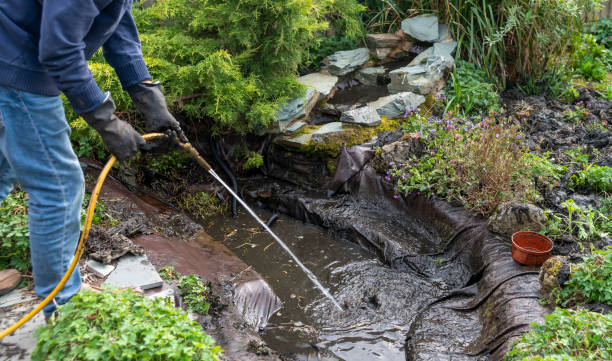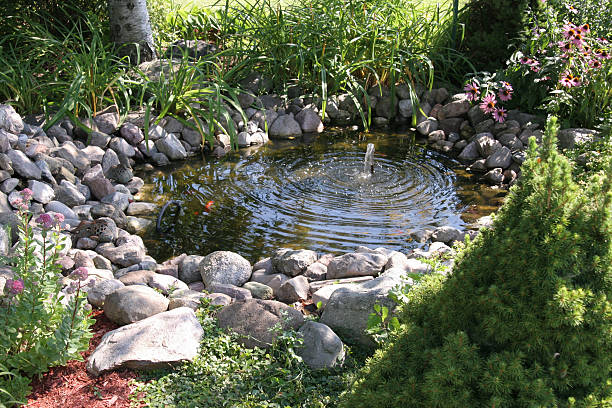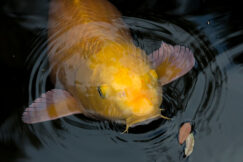Ponds are lovely landscape elements that enhance your property and attract animals. Additionally, they give your house grace and elegance, making it attractive and tranquil to look at.
Ponds still need some upkeep, particularly when filling and emptying water.
If you need to fill in or remove your pond, it could be challenging to know where to begin. A little assistance can go a long way because these processes are usually more complicated than they appear to be.
We first need to be aware of a few crucial details before diving headfirst into filling a pond with water.
Keeping the pond water clean
Your pond’s water must always be kept free of debris. Skim off the leaves that fall into the pond using a net or a skimmer. Water flow can be controlled by a waterfall, which greatly enhances the aesthetics of the pond. Additional pond tinting will help keep the water cool during the sweltering summer.
Additionally, stay away from overfeeding and overfertilizing the plants and fish because doing so might taint the water and harm your pond’s environment.
Using biology and beneficial bacteria to your aid
A pond’s ecosystem is like a blank piece of paper when it is first filled; no bacteria are present. Fish and organic waste are broken down by bacteria, keeping the water clear and ammonia-free.
Fish gills and waste products introduce ammonia to pond water. A new pond is sensitive t rising ammonia levels because it lacks microorganisms, and this rise in ammonia levels can kill fish.
You can produce this highly beneficial bacteria by adding stones, sand, and gravel from an existing pond, an appropriate filter, and a good pond liner. If you want more, add more Nitroso Pira from another pond. If none are available nearby, you may purchase chilled Nitroso Pira at any aquarium retailer.
Another thing to remember is that it’s best to release a small number of fish simultaneously because more fish equals more ammonia. You can eventually add more fish once the pond has time to develop itself.
Shielding your pond
You must shield your pond to keep it safe from the elements. You can install a fence around you to keep unauthorized visitors away from your newly constructed backyard pond and protect yourself from potential liability claims.
Fences help keep predators away from koi fish and other wildlife growing inside your pond.
Additionally, your pond needs to have a spot where aquatic life can hide when attacked by predators so that your fish are protected. You can build swirling fish tunnels, nets (spread around the pond), and decoys for your fish and other species.
Steps to fill a pond with water

Step 1: Dig a hole
Use a tarp or other substantial waterproof cloth to outline the size of the pond you wish to fill before starting the digging process.
Additionally, you can use pre-formed pond liners, which will shield your water from the earth.
Make a deep hole in the space you’ve indicated to accommodate at least a half-inch of water. The depth will vary depending on how you want to use the pond.
For instance, the pond needs to be at least 20 inches deep and have a capacity of 2000 liters if you intend to raise fish.
You should think about the site when you dig the hole.
In the ideal world, a pond’s fish and plants should receive 5 to 6 hours of sunlight every day.
It will produce a lot of leaf detritus if you dig it too close to trees.
Once the hole has been scooped out, take special care to remove any large stones or other debris that could harm the pond liner.
Placing a layer of sand 5cm deep is also a good idea to stop seeds from shooting.
Step 2: Lay out the liner
At this time, a pond liner is placed into the freshly dug pond. Cut off any excess pond liner before inserting it into the pond’s hole. Make sure to use an inside-out-sided pond liner if you’re using one that comes in rolls.
When placing a straight-line pond liner over the surface of the ground and filling it with water, it should face up to prevent fraying or tearing.
You can now fill the pond with water after the pond liner has been properly fitted.
Step 3: Fill the pond with water
The most critical and time-consuming step is this one.
You should use extreme caution because even a minor error could force you to start over.
In essence, you want to fill the tank with water to a particular level to prevent flooding, which could lead to the liner sagging or tearing. A pond can be filled with water in a variety of ways.
Use of rainwater
With this technique, rainwater is used to organically fill a pond because you wouldn’t have to spend any money on the water, even though it would take some time, depending on the weather.
This will be the ideal option if you live in an area where it rains frequently. This might not be the most effective technique to fill your pond if you reside somewhere where it rains infrequently.
Because rainwater has a pH level near 7, it is the ideal liquid to fill ponds. Nevertheless, you must take care of where the water flows before entering the pond.
Collecting rainwater and keeping it for three days before adding it to the pond is recommended to lessen the impact of any contaminants. Smaller ponds, which fill up more quickly, are best for using rainwater to fill.
Water providers
Although this approach is the most expensive, it is also the most reliable and efficient.
It is a high-end alternative that entails having expert water providers supply water to your house.
If you have the money to pay for it, the water is frequently cleaned and available.
The method may not be financially viable for larger ponds. Therefore, it is best suited for tiny ponds that don’t require a lot of water.
Fill your pond using a hose.
Running a hose through your pond until the water level is another method for filling it. Compared to hiring outside water suppliers, this is another affordable option, but it has a disadvantage.
Chlorine is toxic to many fish at large doses and is present in many tap glasses of water. You may test the pH level of your tap water to see if it is safe for your fish or other animals if your pond contains living organisms.
You can purchase a dechlorinating treatment to make the water less dangerous if the chlorine content is too high. Chlorine, for example, even in trace concentrations, can completely wipe out a fish population.
Step 4: Fill the pond with Fiona and Flora
Once the pond’s water has settled, you can add plants, fish, and other animals according to your tastes.
Plants provide color and texture to your pond, giving it personality. By assisting in water filtration, they also act as a natural filters.
Approximately one to two weeks after your pond is filled with water, you can plant aquatic plants. Choose plants that can withstand the circumstances of the pond while searching for the best aquatic pond plants.
One of the many fish species that can flourish in pond water is koi fish.
Make sure the pH in your fish pond is between 7.2 and 7.8 before adding the pond fish. Additionally, the water must be at least 60 degrees Fahrenheit. After the pond has been filled with water for at least three days, everything must be in order before the fish can be released.
Frequently asked questions
How long will it take to fill my pond?
The highest flow rate from a residential water faucet used to refill a pond is probably 2.2 GPM or around 132 gallons per hour. Taking into account evaporation, storm occurrences, and other factors, it would take 17 months for your pond to fill at this rate, running 24 hours a day.
Is it okay to use tap water to fill a pond?
Filling a pond with tap water is acceptable.
The natural equilibrium in your pond can be disturbed by the toxins in chlorinated tap water, so you should avoid using it.
Instead, fill up and maintain the ecosystem of your pond with a hose filled with clean tap water or rainwater.
Conclusion
A pond in your garden is the life of the celebration. Ponds are beautiful and ease stress.
A pond can be filled with water in a variety of methods, including using hose pipes, tap water, rainwater, and water supplies. If you intend to build a pond or fill an existing one, we hope the information we’ve provided will be useful.
Make sure your pond’s water is safe for Fiona and the around plants, no matter what method you use.




